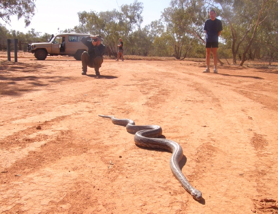 What do tourists value when they visit Australia’s Top End? Are they into shock and awe? In other words do they care as much as the tourism industry about what Australian region has the biggest crocodile? And what about birdwatching?
What do tourists value when they visit Australia’s Top End? Are they into shock and awe? In other words do they care as much as the tourism industry about what Australian region has the biggest crocodile? And what about birdwatching?
Women dominate the huge US birdwatching market, and many want to experience more than just new birds. So are our guides too fixated on twitchers, a small market dominated by men?
If many visitors wish more a more in-depth experience, then does the tourism industry deliver? Are the true experts involved, from the senior citizen who is an authority on native orchids to the grazier or Indigenous family living on their country.
If our wildlife tourism does not deliver to both citizens and visitors, then why not, and how can we fix it?
To examine the problems, potential and possibilities Wildlife Tourism Australia will hold a workshop on connecting wildlife and visitors in the Top End this coming October, to be opened by the Northern Territory Administrator, the Hon. Sally Thomas, AO.

 Topics range from eastern and western approaches to avitourism (bird tourism), comparisons between twitching and true birdwatching to how to accommodate the disabled traveller and Indigenous approaches to wildlife interpretation and difficulties they may face; from jumping financial/bureaucratic hurdles and the topical issue of tourism activities in conservation areas, to loving your (native) cockroach or snake.
Topics range from eastern and western approaches to avitourism (bird tourism), comparisons between twitching and true birdwatching to how to accommodate the disabled traveller and Indigenous approaches to wildlife interpretation and difficulties they may face; from jumping financial/bureaucratic hurdles and the topical issue of tourism activities in conservation areas, to loving your (native) cockroach or snake.
Speakers hail from the NT and the rest of Australia, Asia, Europe and the US (some via the internet), and include American academics and Bo Beolens, one of the UK’s most famous birders.
There are some exciting field trips before and after the workshop, including birdwatching and other wildlife viewing, and Indigenous guiding.
The workshop itself will take place 2nd to 4th October 2013: further details can be found on http://wildlifetourism.org.au/blog/workshop-2013
| More information: |  |
||||
|
|
 |
[1] Rainbos Pitta, Pitta iris, a Top End specialty. © DL Goodfellow
Related News
- Gamba grass: Controlling the nightmare Gamba grass (Andropogon gayanus) is a tall (4 metres high), multi-stemmed plant introduced to Australia in the 1930s as cattle fodder (Csurhes, 2005). The potential dan...
- New bird book from ‘ratbag of the north’ Variously described as an “NT Treasure” and a “ratbag of the north”, eco-tour guide, passionate birder and former buffalo hunter Denise Lawungkurr Goodfellow has published a new bo...
- Birds of Australia's Top End 2020 calendar raises money to fight gamba grass fuelled bushfires A calendar depicting Australian birds from which are endangered by increasingly ferocious bushfires is helping to raise funds to support a volunteer brigade which battles these bla...
- Hand-washing in the bush: Traditional ‘soap’ plants provide alternatives to hand sanitisers Black wattle (Acacia auriculiformis) - ‘soap’ plants that have been long-used by Bininj A few months ago, a message appeared on Facebook. Posted by a family member living in...






